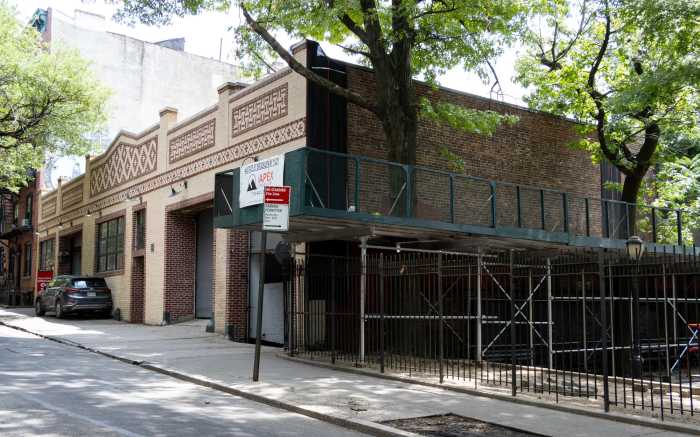Massachusetts Institute of Technology has sued Frank Gehry — the visionary behind Bruce Ratner’s Atlantic Yards — claiming that his three-year-old building on the Cambridge campus is cracking apart.
The suit, which seeks unspecified damages, was filed last week in a Boston civil court. It charges that Gehry’s $300-million Stata Center (pictured), with a ziggurat design similar to his plans for the “Miss Brooklyn” tower at the gateway to the Atlantic Yards complex in Prospect Heights, is so riddled with cracks that mold has formed and drainage is backing up inside.
“Gehry breached its duties by providing deficient design services and drawings,” says the suit, which seeks damages and reimbursement of the $1.5 million that the institution of higher learning spent to repair the damage.
Gehry Partners, the architect’s Los Angeles-based firm, was paid $15 million for the Stata Center design. The innovative building, which Gehry once said “looks like a party of drunken robots got together to celebrate,” has been hailed by critics and its users since it opened in spring, 2004.
But its janitors were never fans.
Almost immediately, according to the suit, the center’s outdoor amphitheater began to crack due to drainage problems. And snow and ice slid dangerously down the angled roofs and piled up in ways that blocked emergency exits.
Mold grew on the exterior and there were regular leaks in the roof, the suit continued.
The suit also named Skanska Construction, the New Jersey-based firm that actually built the Stata Center. But a Skanska executive told the Boston Globe that the fault was in Gehry’s flawed plans, not in Skanska’s execution of them.
“This is not a construction issue, never has been,” said Paul Hewins, Skanska executive vice president. He told the Globe that Gehry rejected Skanska’s formal request to create a design that included soft joints and a drainage system in the amphitheater, and “we were told to proceed with the original design.”
As a result, Hewins said, Skanska spent “a few hundred thousand dollars” fixing the problem.
“It was difficult to make the [Gehry] design work,” he added.
Gehry is currently designing Bruce Ratner’s Atlantic Yards mega-development, which has the 52-story Miss Brooklyn tower — and an 18,000-seat basketball arena — as its focal points. A spokesman for Forest City Ratner declined to comment on whether the company was concerned about the design issues raised by the M.I.T. lawsuit.
The arena will be built with public money — and Ratner’s relocated New Jersey Nets would only be a tenant in the state-owned building, said a spokesman for the Empire State Development Corporation, which is partnering with Ratner to build the $4-billion Atlantic Yards project.
The spokesman declined to explain if the public or Ratner would have to pay to repair any flaws in Gehry’s design.
Gehry did not respond to requests for comment from The Brooklyn Paper, but he did tell the New York Times that new buildings such as his “are complicated.”
“They involved a lot of people, and you never quite know where they went wrong,” he said. “A building goes together with seven billion pieces of connective tissue. The chances of it getting done ever without something colliding or some misstep are small.”
He claimed that professors who work in the Stata Center have sent him e-mails saying that they are “dumbfounded that their institution is doing this.
“I think the issues are fairly minor,” he added. “M.I.T. is after our insurance.”
Perhaps, but it’s not the first time that Gehry has had problems at one of his trend-setting buildings. In 2004, he sandblasted parts of his celebrated Walt Disney Concert Hall in Los Angeles after people complained that the aluminum skin caused a blinding glare.
A swirling, $62-million building that Gehry designed for Case Western Reserve in Cleveland was likened by the New York Times to “a tanning mirror” that “sent snow and ice sliding off the sloping stainless-steel roof onto the heads of pedestrians below.”
The Times also reported that three years after Gehry’s celebrated Guggenheim Bilbao opened in 1997, brown stains on the titanium exterior provoked embarrassment and finger-pointing. Gehry said at the time that it was simply a matter of cleaning.
M.I.T. would not officially comment on the pending suit, but after it was filed, critics of the starchitect piled on.
“It really is a disaster,” said former Boston University President John Silber, who attacked the Stata Center in his book, “Architecture of the Absurd: How ‘Genius’ Disfigured a Practical Art.”
“[Gehry] thinks of himself as an artist, as a sculptor. But the trouble is you don’t live in a sculpture and users have to live in this building,” Silber said.


























